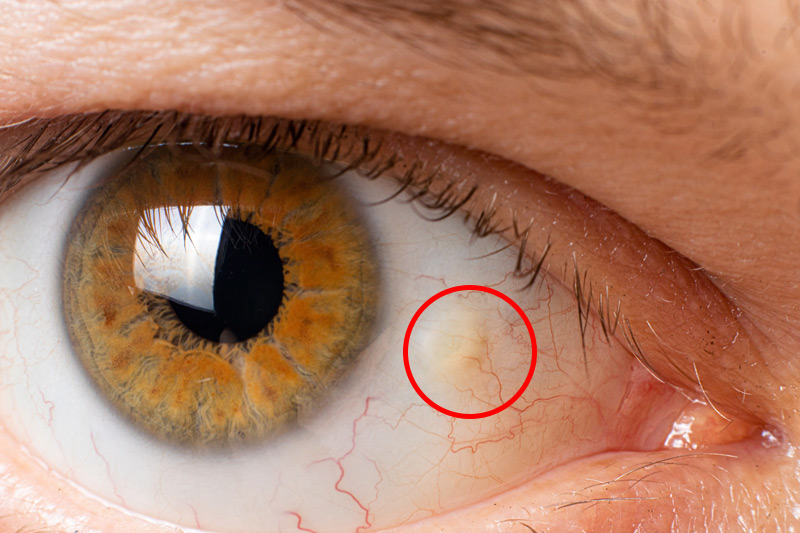Pinguecula is a harmless, yellowish, raised growth on your eyeball. It’s thought to be caused by exposure to sun, wind and dust. Besides the bump, most people don’t have any symptoms with a pinguecula. But some people say it irritates their eyes. Your eye care provider can offer medications if you have symptoms. They can remove it if it bothers you.
Advertisement
Cleveland Clinic is a non-profit academic medical center. Advertising on our site helps support our mission. We do not endorse non-Cleveland Clinic products or services. Policy

A pinguecula (ping-GWEH-kyuh-luh) is a yellowish-white bump on your eye’s conjunctiva. Your conjunctiva is the clear membrane that covers the white part of your eye. A pinguecula typically forms on the inner side of your eyeball, close to your nose. But it sometimes, appears on the other side, too.
Advertisement
Cleveland Clinic is a non-profit academic medical center. Advertising on our site helps support our mission. We do not endorse non-Cleveland Clinic products or services. Policy
Pingueculae are common and harmless growths. They form after long-time exposure to the elements, especially sunlight. They contain protein, fat or calcium deposits. Pingueculae (plural) don’t go away and may grow a little over time. They usually don’t cause problems, but some people say they irritate their eyes.
A pinguecula looks like a bump or a pimple on your eyeball. It’s a small, raised, round, fleshy growth. It’s usually yellow or white. It might start as a colored spot on your eye that later forms into a lump. Most people don’t feel it, but it can increase eye dryness by disrupting the flow of tears across your eye.
Pingueculitis is an inflamed or irritated pinguecula. It can cause additional symptoms, like:
Scientists think pingueculitis is related to the same environmental irritants that cause the growth.
A pinguecula is a reaction to environmental damage to your conjunctiva. It usually develops over a long period of time, which is why it’s more common with older age. People who spend more time in the elements, especially sunlight, wind, dust and sand, are more likely to develop one — often, in both eyes.
Your pinguecula may grow more aggressively or may be more prone to irritation (pingueculitis) if you continue to expose your eye to the same damaging elements that caused it. Other risk factors include:
Advertisement
In rare cases, a pinguecula can keep growing until it turns into a different growth called a pterygium. A pterygium is essentially a more aggressive pinguecula. It’s more raised and wedge-shaped, has visible blood vessels in it and grows faster. Sometimes, it can grow across your cornea, affecting your vision.
Your eye care provider can diagnose a pinguecula with a normal eye exam. Your provider will use a slit lamp to closely examine the growth. A slit lamp is a microscope that focuses a narrow “slit” of bright light onto your eye. It can help them distinguish between a pinguecula and similar-looking growths.
Most pingueculae won’t need any treatment. If your pinguecula irritates your eye or feels like a foreign body in your eye, your provider may recommend artificial tear drops to treat it. If that doesn’t help enough, they may prescribe medical eye drops, such as steroid eye drops to treat the inflammation.
Most pingueculae don’t need to be removed. But your pinguecula won’t go away on its own. Eye surgery is the only way to remove it. Ophthalmologists can — but don’t often — remove a pinguecula for cosmetic reasons alone. They might suggest removing it under more unusual circumstances, like if it:
You’ll probably have your pinguecula for the rest of your life. But it probably won’t cause you any problems. If your eye gets irritated, eye drops can treat it. Most pingueculae grow very slowly, if at all. Sometimes, in more severe cases, they grow more. If it becomes an issue, you can have it removed.
You can lower your risk of developing a pinguecula if you:
Visit an eye care provider if you have a new growth on your eye and you’re not sure what it is. Also, let them know if your pinguecula causes symptoms or interferes with your vision, or if it seems to be growing and changing. Your provider can check it for changes and recommend appropriate treatments.
A bump on your eye can be strange and unsettling to find, but a pinguecula is a harmless growth. It’s a sign of wear and tear on your eye, but it’s damage already done. Pingueculae are very common: most people have at least one by the age of 70. If it really bothers you, your provider can remove it.
Advertisement
Getting an annual eye exam at Cleveland Clinic can help you catch vision problems early and keep your eyes healthy for years to come.

Last reviewed on 11/22/2024.
Learn more about the Health Library and our editorial process.